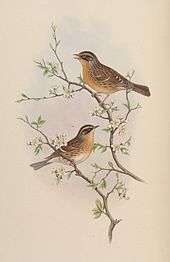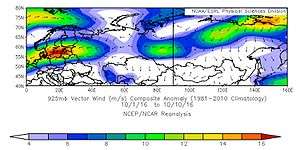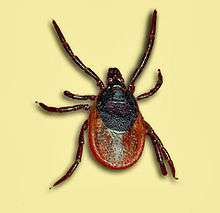Siberian accentor
| Siberian accentor | |
|---|---|
_-_%D0%A1%D0%B8%D0%B1%D0%B8%D1%80%D0%B8%D0%B9%D0%BD_%D1%85%D0%B0%D0%B9%D1%80%D1%83%D1%83%D0%BB%D0%B4%D0%B0%D0%B9_(16435139700).jpg) | |
| Scientific classification | |
| Kingdom: | Animalia |
| Phylum: | Chordata |
| Class: | Aves |
| Order: | Passeriformes |
| Family: | Prunellidae |
| Genus: | Prunella |
| Species: | P. montanella |
| Binomial name | |
| Prunella montanella (Pallas, 1776) | |
 | |
| Breeding summer visitor (ranges are very approximate)Winter visitor | |
The Siberian accentor (Prunella montanella) is a small passerine bird that breeds in northern Russia from the Ural Mountains eastwards across Siberia. It is migratory, wintering in Korea and eastern China, with rare occurrences in western Europe and northwestern North America. Its typical breeding habitat is subarctic deciduous forests and open coniferous woodland, often close to water, although it also occurs in mountains and spruce taiga. It frequents bushes and shrubs in winter, often near streams, but may also be found in dry grassland and woods
The Siberian accentor has brown upperparts and wings, with bright chestnut streaking on its back and a greyish-brown rump and tail. The head has a dark brown crown and a long, wide pale yellow supercilium ("eyebrow"). All plumages are quite similar. The nest is an open cup in dense shrub or a tree into which the female lays four to six glossy deep blue-green eggs that hatch in about ten days. Adults and chicks feed mainly on insects, typically picked off the ground, but sometimes taken from vegetation. In winter, the accentors may also consume seeds or feed near human habitation.
Breeding over a huge area, the Siberian accentor has a large and apparently stable population. It is therefore evaluated as a species of least concern by the International Union for Conservation of Nature (IUCN), although, as a northern breeding species, it may be affected by climate change in the long term. October and November 2016 saw an unprecedented influx of this species into western Europe, reaching as far as the United Kingdom.
Taxonomy
The accentors are a family of small ground-living insectivorous birds, most of which are found in mountainous habitats in Eurasia, although the dunnock is a lowland species. Their relationships with other bird families are uncertain. All accentors are placed in a single genus, Prunella, but within that genus, the Siberian accentor is most similar in appearance to the black-throated, brown, Kozlov's, Radde's and Arabian accentors. These are of comparable in size and typically have a pale supercilium and dark markings on the head or throat.[2] However, a 2013 phylogenetic study indicates that the closest relative of the Siberian accentor is actually the physically dissimilar Japanese accentor.[3]
The Siberian accentor was first described by Russian-based German zoologist Peter Simon Pallas in 1776 as Motacilla montanella.[4] The accentors were moved to their current genus by French ornithologist Louis Jean Pierre Vieillot in 1816.[5]
The Siberian accentor has two subspecies:[6]
- Prunella montanella montanella, (Pallas, 1776),[lower-alpha 1] the nominate subspecies, breeds in northern Russia from just inside Europe eastwards to the Lena River. It also occurs further south, from the Ob to the Amur.
- Prunella montanella badia, Portenko, 1929 breeds in northeastern Siberia eastwards from the Lena, and south to the Sea of Okhotsk.
"Accentor" comes from the old scientific name for the Alpine accentor, Accentor collaris. It derives from Late Latin and means "sing with another" (ad + cantor).[7] The genus name Prunella is from the German Braunelle, "dunnock", a diminutive of braun, "brown", and the specific montanella is a diminutive of Latin montanus, "mountain".[8]
Description

The Siberian accentor is on average 14.5 centimetres (5.7 in) long and weighs 17.5 grams (0.62 oz). The adult of the nominate race has brown upperparts and wings, with bright chestnut streaking on its back and a greyish-brown rump and tail. There are two narrow whitish bars on the folded wings. The head has a dark brown crown, a long, wide pale yellow supercilium, a blackish patch behind the eye and grey sides to the neck. The underparts are ochre yellow, becoming strongly buff on the flanks and greyish on the lower belly. There are rich chestnut streaks on the sides of the breast and the flanks.[6] The iris is yellowish, the sharply pointed bill is dark and the legs are reddish-brown.[9]
All plumages are similar. The female has slightly duller underparts with weaker streaking, and the juvenile is overall duller with brown spots on the breast and chest. The subspecies P . m. badia is somewhat smaller and darker than the nominating form, with richer brown upperparts, deeper buff underparts, and rustier flank streaks.[6]
Adults undergo a complete moult between July and September after breeding has finished. Juvenile birds have a partial moult in the same time period, replacing head, body and some wing covert feathers.[10]
The only species that can potentially be confused with the Siberian accentor is the related black-throated accentor, since first-autumn birds of the latter species may have a relatively inconspicuous dark throat. The Siberian accentor is still distinguishable by its rustier back colour, yellow (not off-white) supercilium and the absence of a white line below the black face mask.[11][12]
Voice
The call of the Siberian accentor is a trisyllabic ti-ti-ti. The male's song, given from the top of a bush or tree, is a loud, high chirichiriri, variously described as similar to that of the Japanese accentor,[9] the dunnock[6] or the black-throated accentor.[10] Breeding birds sing most vigorously early in the season, particularly at dawn, and some individuals may also sing on migration.[10]
Distribution and habitat
.jpg)
The Siberian accentor breeds in a belt across northern Russia east from just west of the Ural Mountains to the Pacific coast, with a second, more fragmented, band across southern Siberia. It is migratory, wintering in east China and Korea.[11][12] It is only rarely recorded in Japan in winter.[9]
The breeding habitat is subarctic willow and birch forests, and open coniferous woodland, often close to rivers or bogs, although pairs are also found in mountains and spruce taiga.[6][11] In winter, the Siberian accentor occupies bushes and shrubs, often near streams, but may also be found in dry grassland and woods.[9]
Movements
Siberian accentors leave the north of their breeding range from mid-September onwards, but may stay for a further month or two in the south. In spring, returning birds pass through Mongolia from the end of March and south easternmost Russia in April and May, reaching their breeding grounds in May, perhaps as late as June in the far north.[10]
Vagrant birds have been recorded in Kazakhstan, Lebanon and several European countries,[1] as well as in North America.[13] Although Alaskan records, like those in western Europe, are mainly from late September to November, occurrences in Canada are less predictable although mostly in autumn and winter.[14]
October–November 2016 influx

October and early November 2016 saw an unprecedented influx of Siberian accentors into western Europe, including provisional first records for Estonia,[15] Germany,[16] the Netherlands and the UK,[17][18] in some cases attracting national attention and hundreds of twitchers.[19][20]
Prior to 2015, only 32 individuals had been recorded in western Europe, the majority in Finland and Sweden, but in October and early November 2016 at least 232 were reported. Records were from the Czech Republic (1), Denmark (12), Estonia (8), Finland (74), Germany (10), Latvia (9), Lithuania (4), Norway (10), Poland (11), Sweden (74) and the UK (13).[21] The UK Met Office suggested that the influx of accentors was driven by strong and persistent easterly winds from Siberia,[22] partially driven by a high-pressure area centred over Scandinavia.[23] Another weather system produced easterlies in western Asia during the same period.[24]
Behaviour
Siberian accentors are typically skulking birds, readily disappearing into cover.[10] They have an above average ability to maintain their body temperature in cold conditions, an adaptation to their sometimes cold environment.[25]
Breeding
The breeding season of the Siberian accentor is from June to August. Little is known about territorial or breeding behaviour, but birds of the nominate subspecies tend to occur in small groups of two to six closely spaced nests. This clumping does not appear to be shown by the southern subspecies, P. m. badia. The nest is an open cup built 0.4–8 metres (1 ft 4 in–26 ft 3 in) above the ground in dense shrub, or where branches fork in a tree. The nest is constructed from coarse vegetation such as twigs and leaves, and lined with hair or fine grasses.[6] The eggs are a glossy deep blue-green and measure 18.6 by 13.7 millimetres (0.73 in × 0.54 in); they weigh about 1.9 grams (0.067 oz). The clutch of four to six eggs is incubated by the female for about ten days to hatching and the downy brown-black chicks are then fed by both parents. They are able to breed in the following year.[10]
Two broods may be produced in the south of the range, just one further north.[6]
Feeding
The Siberian accentor feeds mainly on insects, typically picked off the ground, but sometimes taken from vegetation including bushes and trees, and frequently from near snow fields. Young birds are fed mainly on insects, especially the larvae of beetles, several food items being carried to the nest at each visit.[10]
Seeds may be consumed in winter, and the accentors may also then feed near human habitation. Food plants include crowberry, bistort and members of the aramanth and birch families.[10]
Status

The total population for the Siberian accentor is uncertain, although estimates for the small European part of the range vary from 100–500 breeding pairs. The breeding range is estimated as 2.2 million square kilometres (0.85 million sq mi), and the population is considered overall to be large and apparently stable. For this reason the Siberian accentor is evaluated as a species of least concern by the IUCN, although as a northern breeding species it may in the long term be affected by climate change.[1]
Breeding densities have been recorded as over 30 pairs/km2[10] in northwestern Russia, depending on habitat, generally becoming lower, around 5 pairs/km2 in the east of the range. Weather is also a factor, with an atypically high density of 7.4 birds/km2 being recorded in the Taymyr Peninsula in 1983.[6][lower-alpha 2]
The Siberian accentor is parasitised by the taiga tick, which can host the spirochaete Borrelia burgdorferi, the cause of Lyme disease.[26]
Notes
References
- 1 2 3 BirdLife International (2016). "Prunella montanella". IUCN Red List of Threatened Species. Version 3.1. International Union for Conservation of Nature. Retrieved 14 January 2017.
- ↑ Hatchwell, B (2013). del Hoyo, Josep; Elliott, Andrew; Sargatal, Jordi; Christie, David A; de Juana, Eduardo, eds. "Family Prunellidae: Accentors". Handbook of the Birds of the World Alive. Barcelona: Lynx Edicions. Retrieved 13 December 2016. (Subscription required (help)).
- ↑ Drovetski, Sergei V; Semenov, Georgy; Drovetskaya, Sofya; Fadeev, Igor V; Red'kin, Yaroslav A; Voelker, Gary (2013). "Geographic mode of speciation in a mountain specialist avian family endemic to the Palearctic". Ecology and Evolution. 3 (6): 1518–1528. doi:10.1002/ece3.53.
- ↑ Pallas, Peter Simon (1776). Reise durch verschiedene Provinzen des Russischen Reichs (PDF) (in German). 3.2. St. Petersburg: Kayserlichen academie der wissenschaften. p. 695.
- ↑ Vieillot, Louis Jean Pierre (1816). Analyse D'Une Nouvelle Ornithologie Elementaire (in French). Paris: self-published. p. 43.
- 1 2 3 4 5 6 7 8 Hatchwell, B (2013). del Hoyo, Josep; Elliott, Andrew; Sargatal, Jordi; Christie, David A; de Juana, Eduardo, eds. "Siberian Accentor (Prunella montanella)". Handbook of the Birds of the World Alive. Barcelona: Lynx Edicions. Retrieved 14 December 2016. (Subscription required (help)).
- ↑ "Accentor". Oxford English Dictionary (3rd ed.). Oxford University Press. September 2005. (Subscription or UK public library membership required.)
- ↑ Jobling, James A. (2010). The Helm Dictionary of Scientific Bird Names. London, United Kingdom: Christopher Helm. pp. 259, 318. ISBN 978-1-4081-2501-4.
- 1 2 3 4 Brazil, Mark (2009). Birds of East Asia. London: A & C Black. p. 454. ISBN 0-7136-7040-1.
- 1 2 3 4 5 6 7 8 9 Cramp, Stanley, ed. (1988). "Prunella montanella Siberian accentor". Handbook of the birds of Europe the Middle East and North Africa. The Birds of the Western Palearctic. Volume V: Tyrant Flycatchers to Thrushes. Oxford: Oxford University Press. pp. 560–564. ISBN 0-19-857508-4.
- 1 2 3 Mullarney, Killian; Svensson, Lars; Zetterstrom, Dan; Grant, Peter (1999). Collins Bird Guide. London: Collins. p. 274. ISBN 0-00-219728-6.
- 1 2 Johnsson, Lars (1992). Birds of Europe with North Africa and the Middle East. London: A&C Black. p. 382. ISBN 0-7136-8096-2.
- ↑ Dunn, Jon L; Alderfer, Jonathan K; Lehman, Paul E, eds. (1999). National Geographic Field Guide to the Birds of North America (third ed.). Washington D C: National Geographic Society. p. 360. ISBN 0-7922-7451-2.
- ↑ Toochin, Rick; Cecile, Don. "Status and Occurrence of Siberian Accentor (Prunella montanella) in British Columbia" (PDF). University of British Columbia. Retrieved 24 December 2016.
- ↑ Copete, José Luis (14 Oct 2016). "Siberian Accentor in Estonia". Handbook of Birds of the World Alive. Retrieved 26 December 2016.
- ↑ Copete, José Luis (14 Oct 2016). "Siberian Accentor in Germany". Handbook of Birds of the World Alive. Retrieved 26 December 2016.
- ↑ Copetened, José Luis (21 Oct 2016). "Siberian Accentor in the Netherlands". Handbook of Birds of the World Alive. Retrieved 26 December 2016.
- ↑ Copete, José Luis (10 Oct 2016). "Siberian Accentor in Great Britain". Handbook of Birds of the World Alive. Retrieved 26 December 2016.
- ↑ Telegraph reporters (14 October 2016). "Twitchers flock to village car park to catch glimpse of rare Siberian bird never seen in the UK before". The Daily Telegraph. London: Telegraph Media Group. Retrieved 26 December 2016.
- ↑ van Heel, Leon (21 October 2016). "Vogelaars rukken massaal uit voor eerste bergheggenmus ooit". Algemeen Dagblad (in Dutch). Rotterdam: De Persgroep. Retrieved 27 December 2016.
- ↑ Evans, Lee (January 2017). "UK bird sightings". Birdwatching. Peterborough: Bauer Media. p. 97.
- ↑ Met Office Press Office (29 December 2016). "Has the weather played a role in bringing unusual birds to Britain during 2016?". The Met Office. Retrieved 30 December 2016.
- ↑ "October 2016". Met Office. 3 November 2016. Retrieved 31 December 2016.
- ↑ "925mb Vector Wind Composite Anomaly, 1-10 October 2016". National Oceanic and Atmospheric Administration: Earth System Research Laboratory. Retrieved 31 December 2016.
- ↑ Liu, Jin-song; Chen, Ming-huan; Wang, Ying; Wang, Xiao-heng; Song, Chun-guang (2004). "Metabolic thermogenesis of Siberian accentor (Prunella montanella)" (PDF). Zoological Research (in Chinese with English abstract). 25 (2): 117–121.
- ↑ Anderson, John F; Magnarelli, Louis A (1993). "Epizootiology of Lyme disease-causing borreliae". Clinics in Dermatology. 11 (3): 339–351. doi:10.1016/0738-081X(93)90088-T.
External links
| Wikimedia Commons has media related to Prunella montanella. |
